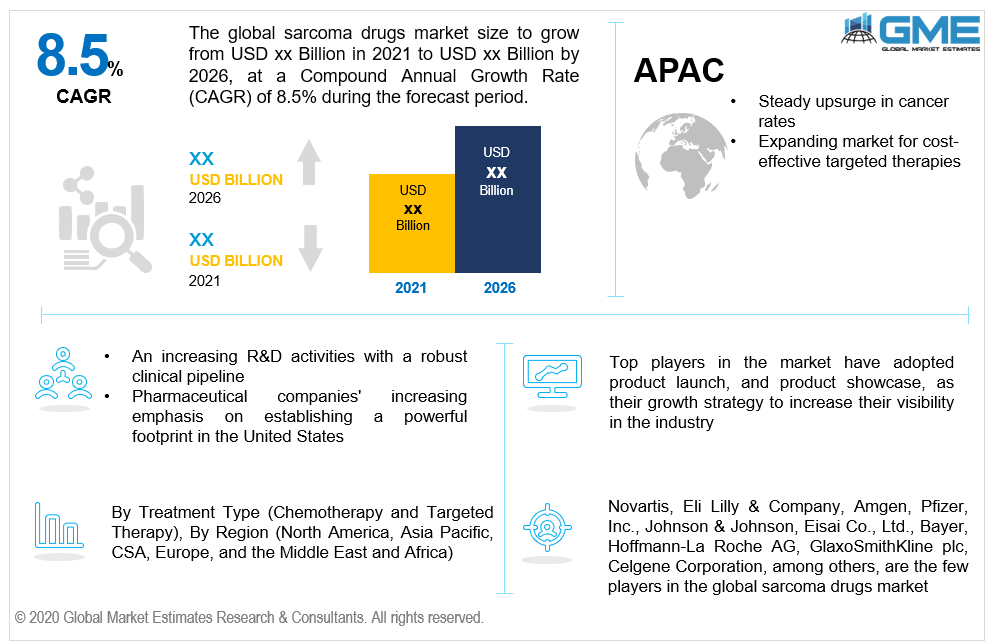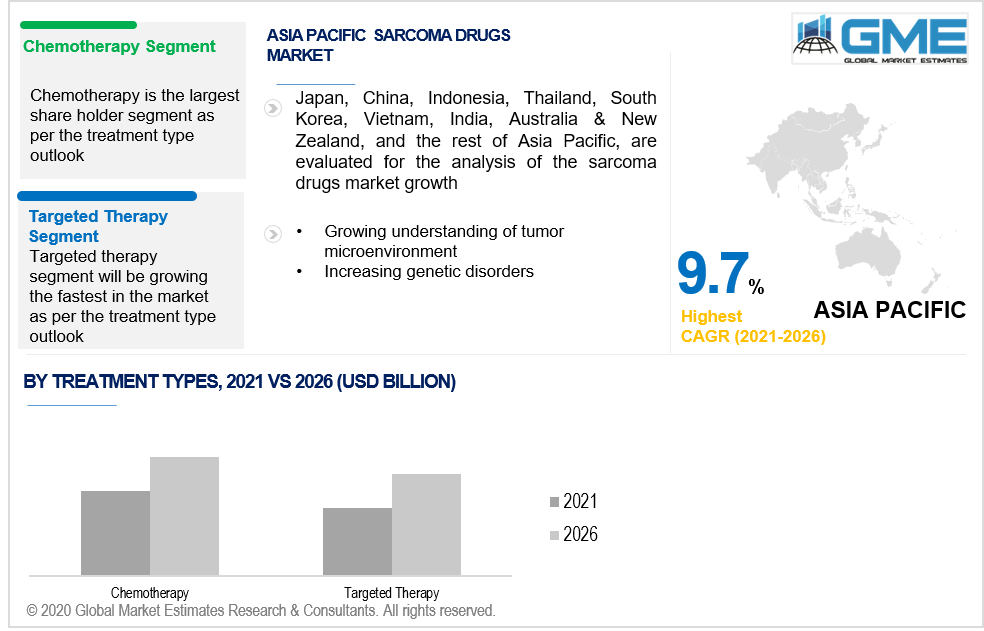
Global Sarcoma Drugs Market Size, Trends & Analysis - Forecasts to 2026 By Treatment Type (Chemotherapy, Targeted Therapy), By Region (North America, Asia Pacific, CSA, Europe, and the Middle East and Africa); Company Market Share Analysis, End-User Landscape, and Competitor Analysis.
Sarcoma is an uncommon type of cancer, and it differs from carcinomas in one important aspect, that is sarcoma arises only in a distinct type of tissue known as connective tissue. Furthermore, it is not classified as a tumor, but it can be fatal if cancer progresses to other areas of the body. Sarcoma is cancer that affects the muscles, bones, fats, nerves, cartilage, and blood vessels in the arms and legs. They may, however, occur in other parts of the body as well. The demand for sarcoma drugs is expected to expand at a healthy rate due to the discovery & adoption of new drugs for treatment, a strong pipeline in the production process, increased R&D spending, and the increasing prevalence of soft tissue sarcomas.
Technical advancements in medical care and diagnosis, as well as the increasing prevalence of sarcoma and other skin cancers, drive sarcoma drug market demand. Furthermore, the demand for low-cost therapeutics in developing regions presents a growth opportunity for the sarcoma drugs market. However, adverse treatment effects could stymie the global sarcoma drugs market. Also, strict legislative requirements, detrimental therapy side effects, and rising radiotherapy & chemotherapy costs may impede the growth of the sarcoma drugs market throughout the forecast period.
In 2020, Tazverik (tazemetostat) was given advanced clearance by the US Food and Drug Administration for the care of adults and pediatric patients aged 16 years & older with metastatic (cancer cells spreading to different areas of the body) or locally progressive cancer (when cancer has grown beyond the body part in which it began but has not yet progressed to remote areas of the body) epithelioid sarcoma is not suitable for full excision (removing any of a membrane, anatomy, or organs surgically). An epithelioid sarcoma is an unusual form of soft tissue sarcoma that typically affects young adults.
Patient Assistance Programs (PAPs) were created as an attempt to support people who do not have health care or prescription medication benefits in obtaining the medicine they need. These services are typically offered by insurance companies, which deliver inexpensiveprescription medications to people suffering from chronic disorders.Pharmaceutical firms offer drugs to charities, and then provide them to eligible customers. Several large pharmaceutical firms, including Pfizer and Eli Lilly, have recently launched similar services to assist uninsured patients struggling with chronic diseases.As a result of the large volume of PAPs, uninsured cancer patients will now get cancer treatments, which is likely to boost demand growth in the sarcoma drugs market.
Increased occurrences of sarcoma and other forms of cancer are likely to drive development in the global sarcoma drug market. Growing research and development on molecular and selective prescription medications for cancer therapy, as well as patent renewal, are two of the main driving forces. Increased healthcare investment per capita for standard medical treatment and numerous innovative therapies further contributes to the development of the global sarcoma drugs market. Furthermore, the growing reliance on precision medication combined with significant expenditure on anti-cancer therapy science is expected to open up new avenues for the global sarcoma drugs market throughout the forecast period.

Based on the treatment type, the market for sarcoma drugs is classified as chemotherapy, targeted therapy. Chemotherapy holds the largest share in the market of the sarcoma drugs market. Chemotherapy is the most often practiced mode of therapy to halt or delay the development of cancer cells. Surgery and radiation treatment remove, destroy, or damage cancer cells in a certain region, while chemotherapy operates across the body. This implies that chemotherapy can kill and destroy cancer cells that have migrated to different areas of the body, far from the initial tumor. Moreover, as per a 2015 report on the patterns in undergoing chemotherapy for patients with advanced cancer, the percentage of patients undergoing chemotherapy rose sequentially at the terminal phase. Doxorubicin, ifosfamide, trabectedin, Temozolomide, and other chemotherapy medications are used to treat sarcoma. Chemotherapy is the main cure for sarcomas, so the demand for chemotherapy is assumed to rise over the forecast period. Nevertheless, because of its greater effectiveness, and steadily growing knowledge amongst core demographics, targeted treatment is likely to witness a greater uptake or growth throughout the forecast period.

As per the geographical analysis, the market can be classified into North America (the US, Canada, and Mexico), Asia Pacific (India, China, Japan, Malaysia, Singapore, and Rest of Asia Pacific), Europe (Germany, United Kingdom, Italy, France, Spain, Netherlands, and Rest of Europe), Middle East & Africa and Central South America. Geographically, North America reports the largest market share attributable to elevated healthcare spending, attractive health care premiums for medication, and a growing volume of patients suffering from sarcoma. As per the American Cancer Society, about 12,750 radically novel sarcoma cases have been reported in the United States with 7,240 men and 5,510 women affected. In the context of death, about 5,270 Americans died from sarcoma in 2019. Additionally, per year, about 40 people out of one million in the United States are diagnosed with sarcoma.
Pharmaceutical companies are working on discovering medications that can alleviate the effects of sarcoma in order to combat this disease. The demand for sarcoma medicines is presumed to expand rapidly in this area over the forecast period, contributing to people's increasing acceptance of new therapies and corporations' increasing emphasis on establishing a powerful footprint in the United States. Europe has the second-largest share of the market owing to growth in genetic diseases and the existence of sophisticated treatment facilities.Because of the steady upsurge in cancer rates and an expanded market for cost-effective targeted therapies, Asia-Pacific is projected to contribute to the highest CAGR for the sarcoma drugs marketthroughout the forecast period.
Novartis, Eli Lilly& Company, Amgen, Pfizer, Inc., Johnson & Johnson, Eisai Co., Ltd., Bayer, Hoffmann-La Roche AG, GlaxoSmithKline plc, Celgene Corporation, among others, are the few players in the sarcoma drugs market.
Please note: This is not an exhaustive list of companies profiled in the report.
Chapter 1 Methodology
1.1 Market Scope & Definitions
1.2 Estimates & Forecast Calculation
1.3 Historical Data Overview And Validation
1.4 Data Sources
1.4.1 Secondary
1.4.2 Primary
Chapter 2 Report Outlook
2.1 Global Sarcoma Drugs Industry Overview, 2019-2026
2.1.1 Industry Overview
2.1.2 Treatment Types Overview
2.1.3 Regional Overview
Chapter 3 Global Sarcoma Drugs Market Trends
3.1 Market Segmentation
3.2 Industry Background, 2019-2026
3.3 Market Key Trends
3.3.1 Positive Trends
3.3.1.1 Technology Advancement in Healthcare Industry
3.3.1.2 Increasing Funds by Government to Develop NovelMedicines
3.3.2 Industry Challenges
3.3.2.1 Limited Study and Industry Participants
3.4 Prospective Growth Scenario
3.4.1 Treatment Types Growth Scenario
3.5 COVID-19 Influence over Industry Growth
3.6 Porter’s Analysis
3.7 PESTEL Analysis
3.8 Value Chain & Supply Chain Analysis
3.9 Regulatory Framework
3.9.1 North America
3.9.2 Europe
3.9.3 APAC
3.9.4 LATAM
3.9.5 MEA
3.10 Technology Overview
3.11 Market Share Analysis, 2020
3.11.1 Company Positioning Overview, 2020
Chapter 4 Global Sarcoma Drugs Market, By Treatment Types
4.1 Treatment Types Outlook
4.2 Chemotherapy
4.2.1 Market Size, By Region, 2019-2026 (USD Million)
4.3 Supportive Care
4.3.1 Market Size, By Region, 2019-2026 (USD Million)
4.4 Targeted Therapy
4.4.1 Market Size, By Region, 2019-2026 (USD Million)
4.5 Stem Cell Transplant
4.5.1 Market Size, By Region, 2019-2026 (USD Million)
Chapter 5 Global Sarcoma Drugs Market, By Region
5.1 Regional outlook
5.2 North America
5.2.1 Market Size, By Country 2019-2026 (USD Million)
5.2.2 Market Size, By Treatment Types, 2019-2026 (USD Million)
5.2.4 U.S.
5.2.4.1 Market Size, By Treatment Types, 2019-2026 (USD Million)
5.2.5 Canada
5.2.5.1 Market Size, By Treatment Types, 2019-2026 (USD Million)
5.3 Europe
5.3.1 Market Size, By Country 2019-2026 (USD Million)
5.3.2 Market Size, By Treatment Types, 2019-2026 (USD Million)
5.3.4 Germany
5.2.4.1 Market Size, By Treatment Types, 2019-2026 (USD Million)
5.3.5 UK
5.3.5.1 Market Size, By Treatment Types, 2019-2026 (USD Million)
5.3.6 France
5.3.6.1 Market Size, By Treatment Types, 2019-2026 (USD Million)
5.3.7 Italy
5.3.7.1 Market Size, By Treatment Types, 2019-2026 (USD Million)
5.3.8 Spain
5.3.8.1 Market Size, By Treatment Types, 2019-2026 (USD Million)
5.3.9 Russia
5.3.9.1 Market Size, By Treatment Types, 2019-2026 (USD Million)
5.4 Asia Pacific
5.4.1 Market Size, By Country 2019-2026 (USD Million)
5.4.2 Market Size, By Treatment Types, 2019-2026 (USD Million)
5.4.4 China
5.4.4.1 Market Size, By Treatment Types, 2019-2026 (USD Million)
5.4.5 India
5.4.5.1 Market Size, By Treatment Types, 2019-2026 (USD Million)
5.4.6 Japan
5.4.6.1 Market Size, By Treatment Types, 2019-2026 (USD Million)
5.4.7 Australia
5.4.7.1 Market Size, By Treatment Types, 2019-2026 (USD Million)
5.4.8 South Korea
5.4.8.1 Market Size, By Treatment Types, 2019-2026 (USD Million)
5.5 Latin America
5.5.1 Market Size, By Country 2019-2026 (USD Million)
5.5.2 Market Size, By Treatment Types, 2019-2026 (USD Million)
5.5.4 Brazil
5.5.4.1 Market Size, By Treatment Types, 2019-2026 (USD Million)
5.5.5 Mexico
5.5.5.1 Market Size, By Treatment Types, 2019-2026 (USD Million)
5.5.5 Argentina
5.5.6.1 Market Size, By Treatment Types, 2019-2026 (USD Million)
5.5 MEA
5.5.1 Market Size, By Country 2019-2026 (USD Million)
5.5.2 Market Size, By Treatment Types, 2019-2026 (USD Million)
5.5.4 Saudi Arabia
5.5.4.1 Market Size, By Treatment Types, 2019-2026 (USD Million)
5.5.5 UAE
5.5.5.1 Market Size, By Treatment Types, 2019-2026 (USD Million)
5.5.5 South Africa
5.5.5.1 Market Size, By Treatment Types, 2019-2026 (USD Million)
Chapter 6 Company Landscape
6.1 Competitive Analysis, 2020
6.2 Novartis
6.2.1 Company Overview
6.2.2 Financial Analysis
6.2.3 Strategic Positioning
6.2.4 Info Graphic Analysis
6.3 Eli Lilly & Company
6.3.1 Company Overview
6.3.2 Financial Analysis
6.3.3 Strategic Positioning
6.3.4 Info Graphic Analysis
6.4 Amgen
6.4.1 Company Overview
6.4.2 Financial Analysis
6.4.3 Strategic Positioning
6.4.4 Info Graphic Analysis
6.5 Pfizer, Inc.
6.5.1 Company Overview
6.5.2 Financial Analysis
6.5.3 Strategic Positioning
6.5.4 Info Graphic Analysis
6.6 Johnson & Johnson
6.6.1 Company Overview
6.6.2 Financial Analysis
6.6.3 Strategic Positioning
6.6.4 Info Graphic Analysis
6.7 Eisai Co., Ltd.
6.7.1 Company Overview
6.7.2 Financial Analysis
6.7.3 Strategic Positioning
6.7.4 Info Graphic Analysis
6.8 Bayer
6.8.1 Company Overview
6.8.2 Financial Analysis
6.8.3 Strategic Positioning
6.8.4 Info Graphic Analysis
6.9 Hoffmann-La Roche AG
6.9.1 Company Overview
6.9.2 Financial Analysis
6.9.3 Strategic Positioning
6.9.4 Info Graphic Analysis
6.10 GlaxoSmithKline plc
6.10.1 Company Overview
6.10.2 Financial Analysis
6.10.3 Strategic Positioning
6.10.4 Info Graphic Analysis
6.11 Celgene Corporation
6.11.1 Company Overview
6.11.2 Financial Analysis
6.11.3 Strategic Positioning
6.11.4 Info Graphic Analysis
6.12 Other Companies
6.12.1 Company Overview
6.12.2 Financial Analysis
6.12.3 Strategic Positioning
6.12.4 Info Graphic Analysis
The Global Sarcoma Drugs Market has been studied from the year 2019 till 2026. However, the CAGR provided in the report is from the year 2021 to 2026. The research methodology involved three stages: Desk research, Primary research, and Analysis & Output from the entire research process.

The desk research involved a robust background study which meant referring to paid and unpaid databases to understand the market dynamics; mapping contracts from press releases; identifying the key players in the market, studying their product portfolio, competition level, annual reports/SEC filings & investor presentations; and learning the demand and supply-side analysis for the Sarcoma Drugs Market.

The primary research activity included telephonic conversations with more than 50 tier 1 industry consultants, distributors, and end-use product manufacturers.

Finally, based on the above thorough research process, an in-depth analysis was carried out considering the following aspects: market attractiveness, current & future market trends, market share analysis, SWOT analysis of the company and customer analytics.

Tailor made solutions just for you
80% of our clients seek made-to-order reports. How do you want us to tailor yours?
OUR CLIENTS